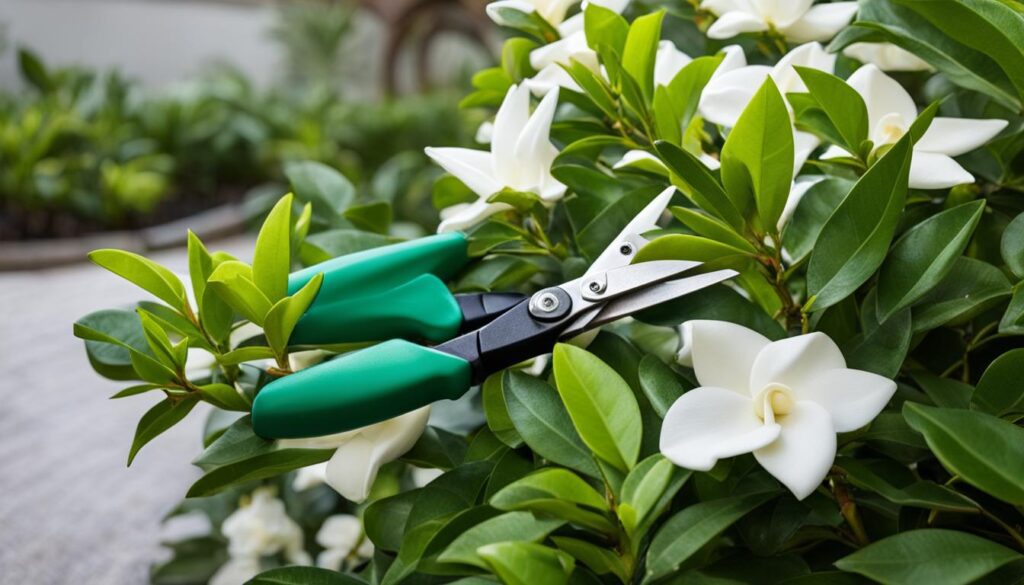Gardenias are a popular choice among warm-weather gardeners due to their stunning appearance and exquisite scent. While pruning is not necessary for the overall health of a gardenia bush, it can help maintain its shape and size. Pruning every other year or as needed is sufficient to keep gardenias manageable.
Use sharp shears to prevent jagged cuts and potential disease. It is generally safe to prune both green and brown wood, as most gardenia varieties set buds on both types of wood.
The best time to prune gardenias is after the blooms have faded in the summer. This timing allows you to trim back older wood without risking cutting away newly set buds. Regular pruning will prevent your gardenia from becoming unruly and maintain its desired shape.
To prune a gardenia bush, begin by making a plan and deciding on the desired size and shape. Trim the branches at a 45-degree angle, starting with the oldest, thickest branches. Remove about half of the oldest branches to allow space for new growth. Trim the remaining branches to your desired height and shape, making cuts above a stem branch or leaf node to encourage new growth.
Regularly deadhead your gardenia bush by pinching off brown or black blooms to promote longer-lasting flowers and increased blooming. Clean and disinfect your pruning shears before and after use to prevent the spread of diseases.
Remember, pruning gardenias is not essential, but it can be beneficial for maintaining the shape and size of the bush. By following proper pruning techniques, such as cutting back after blooming and using sharp shears at a 45-degree angle, you can keep your gardenia bush healthy and attractive. With a little care and attention, your gardenias will thrive and reward you with their stunning blooms and captivating fragrance.
When to Prune Gardenias
The ideal time to prune gardenias is right after the flowers have faded in the summer. This timing allows you to trim back older wood without risking cutting away newly set buds. Most gardenia varieties bloom once a year, but some can bloom multiple times. Check the blooming cycle of your specific variety before pruning. Pruning your gardenia regularly will prevent it from becoming unruly and maintain its desired shape.
Timing is Key
Pruning gardenias after blooming ensures that you won’t accidentally remove newly formed buds and sacrifice future blossoms. The best time to prune is when the flowers have faded, typically in the summer months. This timing also allows you to take advantage of the plant’s natural growth cycle, as gardenias tend to produce new growth right after blooming. By pruning at the right time, you can shape your gardenia and encourage healthy, vibrant blooms year after year.
- Prune after blooming to avoid cutting away new buds
- Check the blooming cycle of your gardenia variety
- Regular pruning maintains the desired shape of your gardenia
Pruning your gardenia at the right time is crucial for its overall health and appearance. By following the recommended guidelines, you can ensure that your gardenia bush remains well-maintained and continues to delight you with its beautiful blooms.
How to Prune Gardenias
To prune a gardenia bush effectively, you will need a pair of sharp pruning shears. Follow these gardenia pruning techniques to shape your plants and promote healthy growth:
- Plan and Decide: Before you start pruning, take some time to decide on the desired size and shape of your gardenia. This will help you determine how much to trim and where to make cuts.
- Angle and Cutting Order: Trim the branches at a 45-degree angle, starting with the oldest and thickest ones. This ensures clean cuts and reduces the risk of disease. Remove about half of the oldest branches to allow room for new growth.
- Height and Shape: Trim the remaining branches to your desired height and shape. Make cuts above a stem branch or leaf node to encourage new growth in the right direction. Avoid cutting too far back, as it may reduce blooming.
- Deadheading: Regularly deadhead your gardenia bush by pinching off brown or black blooms. This practice promotes longer-lasting flowers and increased blooming throughout the season.
- Clean and Disinfect: Clean and disinfect your pruning shears before and after use to prevent the spread of diseases. This simple step helps protect the overall health of your gardenia plant.
By following these proper gardenia pruning techniques, you can shape your gardenias to your liking and ensure their continued beauty. Remember to prune regularly to maintain the desired shape and promote healthy growth. Now that you know how to prune gardenias, it’s time to put your knowledge into action.
Conclusion
Pruning gardenias is an optional but beneficial practice for maintaining the shape and size of your gardenia bush. By following proper pruning techniques, such as cutting back after blooming and using sharp shears at a 45-degree angle, you can ensure the health and attractiveness of your gardenias. Regular pruning helps prevent the plant from becoming overgrown and promotes the growth of new, vibrant branches.
In addition to pruning, it is essential to provide consistent care for your gardenias. This includes watering them regularly, fertilizing appropriately, and checking for any signs of pests or diseases. By maintaining a consistent care routine, you can contribute to the overall health and beauty of your gardenia bushes.
With a little care and attention, your gardenias will thrive and reward you with their stunning blooms and captivating fragrance. So take some time to prune your gardenias, and enjoy the satisfaction of maintaining their shape while creating a picture-perfect garden.
Are the Pruning Techniques for Gardenias and Avocado Trees Similar?
When it comes to pruning avocado tree tips and gardenias, the techniques are quite different. Gardenias require frequent pruning to maintain their shape and promote blooming, whereas avocado trees need minimal pruning to control their size and encourage fruit production. It’s important to understand the specific needs of each plant before attempting to prune them.










